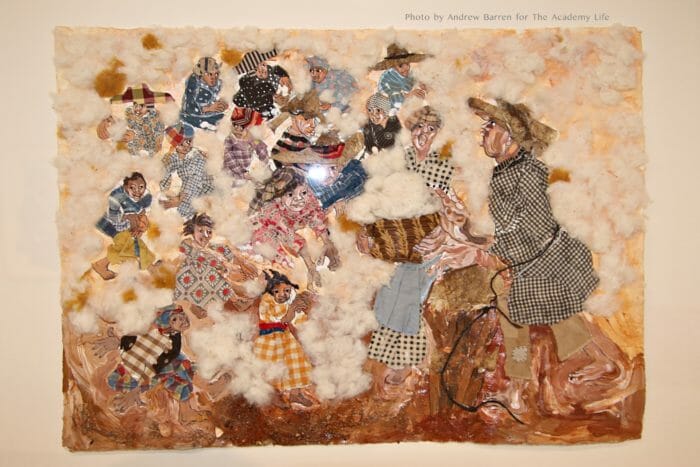Academy’s Morris Hall Gallery features works by Aminah Brenda Lynn Robinson. (Andrew Barren’22/Media)
Eric Dozier, an activist and singer-songwriter, visited our school last week in celebration of Black History Month, and he taught the community an important word: Sankofa, which was coined by King Adinkera of the Akans and translates to “Go back and get it.”
Aminah Brenda Lynn Robinson is a nationally acclaimed artist, and she uses Sankofa as a foundation for her artwork, moving back through time in order to make sense of the present. She is a recipient of the MacArthur Fellowship Award, and her work is displayed in museums in Brooklyn, Tacoma, and Columbus. For the first time in its history, the Columbus Museum of Art has loaned pieces from their collection to a high school. The Columbus Academy has been granted the honor of exhibiting the artwork of Aminah Robinson.
Robinson grew up immersed in art. She first learned to draw from her father, who taught her how to create her own books using “paper and ‘hogmawg,’ a collection of mud, clay, twigs, leaves, lime, animal grease, and glue.” Her mother taught how to weave, knit, and use buttons.
In her lifetime, Robinson produced a vast array of artwork, including sculpture, RagGonNons (pieces to which she adds over time), paintings using rags or cloth, and drawings. She also wrote several books, one of which is titled To Be A Drum, which according to Robinson, is a “reflection of bridges to cross—Africa, the Middle Passage, slavery, civil rights, the artists, the teachers, the heroes, and always the children looking to the future.” Seven of Robinson’s original pieces from To Be a Drum are featured in the Morris Hall Art Gallery.
Carole M. Genshaft, Curator at Large from the Columbus Museum of Art says, “All of Aminah Brenda Lynn Robinson’s work is about the bridges, connections, and journeys that link us as human beings— throughout time and place. . .Another theme that permeates Aminah’s work is the commonalities that all people share regardless of the color of their skin, the clothes they wear, or the language they speak.”
Sankofa is also associated with an Akan saying, “Se wo were fi na wosankofa a yenkyi.” This translates to: “It is not wrong to go back for that which you have forgotten.” Her artwork illustrates the enslavement of African Americans as early as the 16th century, African Americans’ presence in the Revolutionary War, the American Civil War, and the first World War, as well as their leadership in the Civil Rights Movement. She emphasizes the importance of acknowledging the past to honor the dignity and sacrifices of those who came before and to guard against future injustice: “And so even though our ancestors guide us, keep us, they also give us voice so that we can pass it on. And I guess that is the purpose of my work, simply, to pass it on.”
I encourage everyone in our community to visit the Aminah Robinson exhibit. It will be on display through March 7, 2019.








